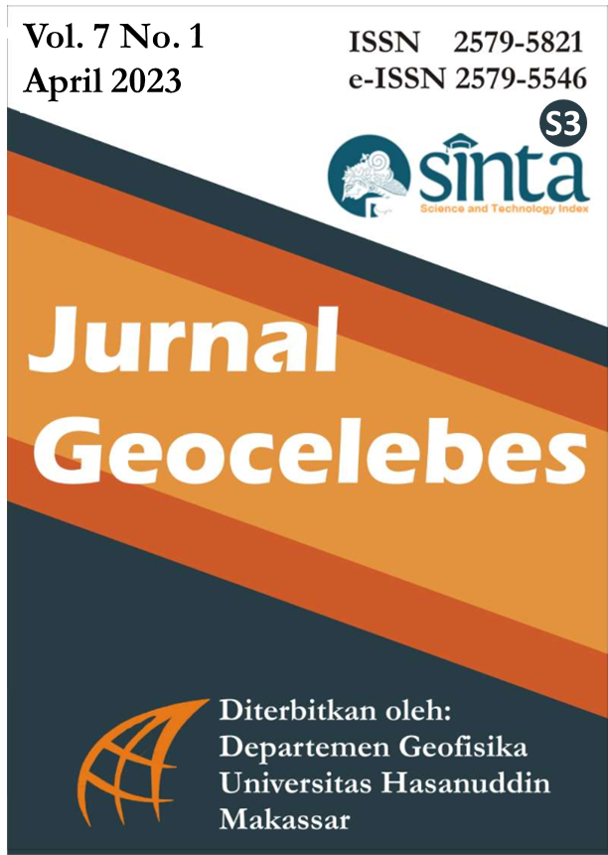Using Grid Search and Guided Random Search (Simulated Annealing) Methods in Determining the Earthquake Hypocenter in the Majalengka Region, West Java on November 11, 2021
Penggunaan Metode Grid Search dengan Guided Random Search (Simulated Annealing) dalam Menentukan Hiposenter Gempa Bumi Daerah Majalengka, Jawa Barat pada 11 November 2021
DOI:
https://doi.org/10.20956/geocelebes.v7i1.19975Keywords:
Earthquakes, grid search, guided random search, hypocenter, simulated annealingAbstract
Tectonic earthquakes are generally caused by the release of energy produced by a pressure from a moving slab. This study aimed to test the use of grid search methods and guided random search in determining the hypocenter position of the earthquake in the case of the Majalengka regional earthquake, West Java which occurred on November 11, 2021. In this study used earthquake source data with the number of 5 stations, are COCO, KAPI, PALK, MBWA, and NWAO which can be accessed on the IRIS. From the results of determining the earthquake hypocenter using the grid search method, the position of the earthquake hypocenter is obtained with a latitude position of 6.596861oS and for a longitude position of 108.2871°E with a depth of 200 km, while from the processing of the simulated annealing method, the latitude position is 6.501645°S and longitude 108.2252°E with depth of 172.1 km. Meanwhile, if we compare the position of the earthquake hypocenter according to IRIS, are the latitude position of 6.6027°S and for the longitude position of 108.105°E with a depth of 164.41 km, because the hypocenter data from IRIS has been revised by a seismologist so that it is used as a reference, the results that are closest to the position according to IRIS are the results of the simulated annealing method.Downloads
References
Aldiamar, F. (2007). Analisa Resiko Gempa dan Pembuatan Respon Spektra Desain untuk Jembatan Suramadu dengan Permodelan Sumber Gempa 3D. Master thesis, Institut Teknologi Bandung.
Arimuko, A., Persada, Y. D., & Subakti, H. (2019). Model Kecepatan 1 - D Gelombang P dan Gelombang S dari Data Hasil Relokasi Hiposenter di Wilayah Gunung Sinabung. Jurnal Meteorologi Klimatologi dan Geofisika, 5(3), 72–79.
https://doi.org/10.36754/jmkg.v5i3.77
Fauzi. (2010). Analisis Data Seismogram untuk Menentukan Parameter Magnitude Gempabumi. Bachelor thesis. Universitas Islam Negeri Syarif Hidayatullah.
Grandis, H. (2009). Pengantar Pemodelan Inversi. Himpunan Ahli Geofisika Indonesia. Jakarta 12540, Indonesia.
Grandis, H., & Dahrin, D. (2014). Constrain Two - Dimensional Inversion of Gravity. Journal of Mathematical and Fundamental Sciences, 46(1), 1–13. https://doi.org/10.5614/j.math.fund.sci.2014.46.1.1
Hamilton, W. (1979). Tectonics of the Indonesian Region. Geol. Surv. Proff. Paper 1078, US Government. Printing Office. Washington, p.114-156.
Milsom, J., Masson, D., Nichols, G., Sikumbang, N., Dwiyanto, B., Parson, L., & Kallagher, H. (1992). The Manokwari Trough and The Western End of The New Guinea Trench. Tectonics, 11(1), 145–153. https://doi.org/10.1029/91TC01257
Nugraha, A.D. (2005). Studi Tomografi 3-D Non Linear untuk Gunung Guntur dengan Menggunakan Waktu Tiba Gelombang P dan S. Master thesis, Institut Teknologi Bandung.
Nurwidyanto, I.M., & Setiawan, A. (2011). Inversi linier least square dengan Matlab (Studi Kasus Model Gravitasi Bola Berlapis). Jurnal Berkala Fisika, 14(3), 93–100. https://ejournal.undip.ac.id/index.php/berkala_fisika/article/view/5009
Ratchkovsky, N.A., Pujol J., & Biswas, N. N. (1998). Relocation of shallow earthquakes in southern Alaska using Joint Hypocenter Determination method. Journal of Seismology. 2(1), 87–102. https://doi.org/10.1023/A:1009758721717
Rodi, W., & Toksoz, M. N. (2000). Grid Search Techniques for Seismic Event Location. Proceedings of the 22nd Annual DoD/DOE Seismic Research Symposium.
Ry, R. V., & Nugraha, A. D. (2012). Penentuan Hiposenter Gempa Mikro Menggunakan Metode Inversi Simulated Annealing pada Lapangan Geotermal “RR”. Jurnal Geofisika, 13(1), 23–31.
Sambridge, M., & Gallagher, K. (1993). Earthquake Hypocenter Location Using Genetic Algorithms. Bulletin Seismological Society of America, 83(5), 1467–1491. https://doi.org/10.1785/BSSA0830051467
Solikhin, A., & Suantika, G. (2008). Laporan Penyelidikan Gempabumi Daerah Kabupaten Bandung dan Sekitarnya Jawa Barat. Pusat Vulkanologi dan Mitigasi Bencana Geologi. Bandung.
van Bemmelen. (1970). The Geology of Indonesia, 2nd ed, Netherlands: Hague.
Downloads
Published
How to Cite
Issue
Section
License
Authors who publish with this journal agree to the following terms:
- Authors retain copyright and grant the journal right of first publication with the work simultaneously licensed under a Creative Commons Attribution License that allows others to share the work with an acknowledgement of the work's authorship and initial publication in this journal.
- Authors are able to enter into separate, additional contractual arrangements for the non-exclusive distribution of the journal's published version of the work (e.g., post it to an institutional repository or publish it in a book), with an acknowledgement of its initial publication in this journal.
- Authors are permitted and encouraged to post their work online (e.g., in institutional repositories or on their website) prior to and during the submission process, as it can lead to productive exchanges, as well as earlier and greater citation of published work (See The Effect of Open Access).



